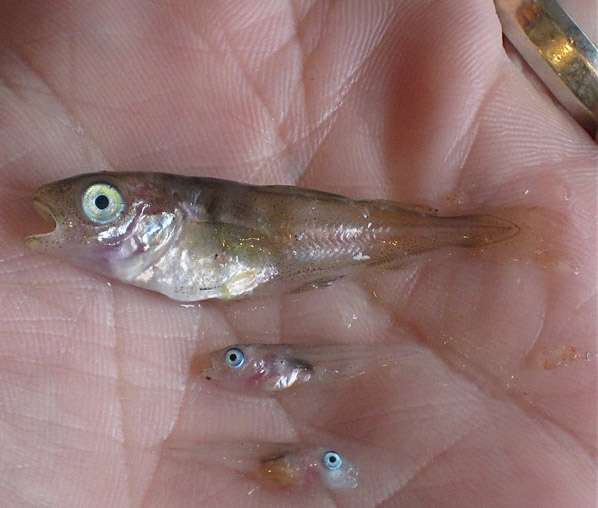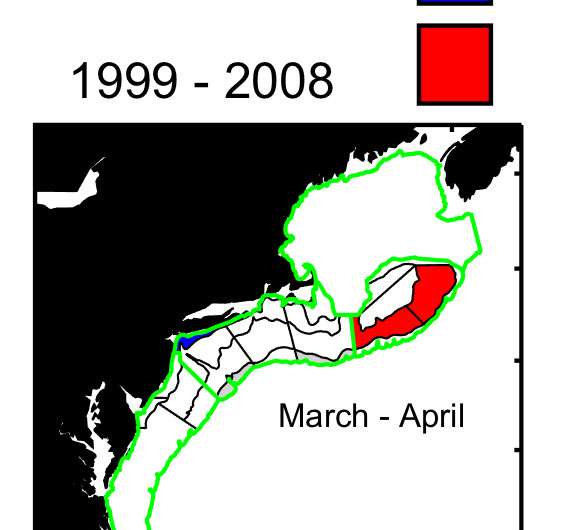Many young fish moving north with adults as climate changes

Numerous studies in the Northeast U.S. have shown that adult marine fish distributions are changing, but few studies have looked at the early life stages of those adult fish to see what is happening to them over time. A new study by NOAA Fisheries researchers has some answers, finding that distributions of young stages and the timing of the life cycle of many fish species are also changing.
Most marine fish have complex life histories with distinct stages - much like frogs. Marine fish spawn small planktonic eggs, approximately 1/20 of an inch in diameter, that move at the whim of ocean currents. These eggs hatch into larvae that have non-functional guts, un-pigmented eyes, and often don't yet have a mouth. Over a period of weeks to months, while drifting in the ocean, larvae develop and grow until they reach a point where they transition into juveniles recognizable as a fish. This complex life history is similar to that of frogs, which grow from eggs to tadpoles to adult frogs.
The distribution of larvae in the sea is determined by where adult fish reproduce and by currents that move these small early life stages around the ocean. In a study published September 23 in the journal PLOS ONE, researchers from NOAA's Northeast Fisheries Science Center (NEFSC) used long-term survey data to compare the distributions of larvae between two decades, from 1977-1987 and from 1999-2008. They also used long-term survey data to compare distributions of adult fish over the same time period.
"The distribution and timing of the life cycle of many fish species are changing," said lead author Harvey Walsh, a fisheries biologist at the NEFSC's Narragansett Laboratory in Rhode Island. "The consequences of these changes for fisheries management need to be considered, but an important first step is documenting that change is occurring."
Walsh and colleagues used data from the 1980s collected during the Marine Resources Monitoring, Assessment, and Prediction Program (MARMAP) and data collected during the 2000s from the NEFSC's ongoing Ecosystem Monitoring (EcoMon) Program. Both programs sampled the entire Northeast U.S. shelf from Cape Hatteras, North Carolina, to Cape Sable, Nova Scotia. Researchers studied 45 larval fish species and 40 adult fish species.

Researchers found that larval stages of 43 percent of the species studied changed distribution, while adult stages of 50 percent of the species shifted distribution over the same time period. Shifts were predominantly northwards or along the shelf for both life stages, which is expected given the warming ocean in the region.
But not all the shifts were northward, or along the shelf. Butterfish and Atlantic mackerel shifted inshore in the Mid-Atlantic Bight, while red hake and silver hake moved into deeper but more inshore waters in the Gulf of Maine. Adult spiny dogfish, little skate and offshore hake shifted southward, perhaps due to differences in fishing pressure, changes in habitat and other stressors.
"While a general northward shift has emerged, better understanding of the seasonal dynamics on the Northeast Shelf and the complexities of Gulf of Maine bathymetry will help explain some of these differences," Walsh said. "It is clear, however, that significant changes are underway."
In addition to distribution changes, the study also found changes in spawning times and locations for some species, implying a link between changes in distribution and changes in the environment. Larvae of winter and spring species like yellowtail flounder generally shifted earlier in the season. Summer and fall species like monkfish shifted later in the season.
In approximately 60 percent of the species studied, distribution changes differed between larval and adult stages, suggesting that the habitat a species uses throughout its life history is also changing. That could have consequences for species like black sea bass and American plaice, among others, as greater migration distances and greater distances between nursery and feeding habitats impact the connectivity of the population.
These results demonstrate that larval fish distributions are changing in the ecosystem, and while the changes are consistent with changing climate, the timing of these changes are more complex and require better understanding of reproductive timing of fishes in the ecosystem.
"It is apparent that fish stocks in the Northeast U.S. Shelf have changed over decades for both larvae and adults," Walsh said, noting that the continuation of long-term observing programs like EcoMon is critical to these types of studies. "These changes will impact the productivity and distribution of these stocks, and that will have significant implications for their assessment and management."
Jon Hare, director of the Narragansett Laboratory and a co-author on the study, agreed. "This study was made possible by the hard work of research vessels crews, officers and scientists over nearly 40 years. Long-term data collection of all life stages is fundamental to understanding the past, present and future of marine fisheries in the Northeast U.S. region."
Journal information: PLoS ONE
Provided by NOAA Headquarters



















